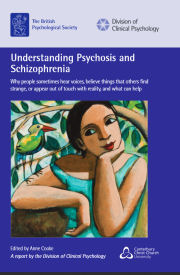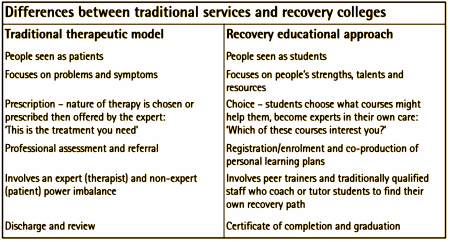 It’s not easy to respond to the British Psychological Society’s [BPS], Understanding Psychosis and Schizophrenia, primarily because of the extensive use of negation throughout the report. In their discussion, the phenomena formerly called a symptom [like hearing voices] is not abnormal, but rather something seen in normal mental life. A negative symptom like anhedonia is not some primary aspect of a disease state but rather the result of being overwhelmed. There is not any underlying condition causing symptoms [the Szaszian formulation of the Myth of Mental Illness]. Medication is not treating some underlying pathology, but rather an optional adjunct some find helpful. Much of what is seen in these conditions is the result of being not understood or not listened to. In the etiologic dimension, the report suggests that these are people who have been traumatized by life experiences – not a flight into fantasy but a reaction to fact.
It’s not easy to respond to the British Psychological Society’s [BPS], Understanding Psychosis and Schizophrenia, primarily because of the extensive use of negation throughout the report. In their discussion, the phenomena formerly called a symptom [like hearing voices] is not abnormal, but rather something seen in normal mental life. A negative symptom like anhedonia is not some primary aspect of a disease state but rather the result of being overwhelmed. There is not any underlying condition causing symptoms [the Szaszian formulation of the Myth of Mental Illness]. Medication is not treating some underlying pathology, but rather an optional adjunct some find helpful. Much of what is seen in these conditions is the result of being not understood or not listened to. In the etiologic dimension, the report suggests that these are people who have been traumatized by life experiences – not a flight into fantasy but a reaction to fact.
The points made in the report are certainly well known to all of us. Besides echoing the words of Thomas Szasz [who is nowhere mentioned in the report], it’s a position similar to the one expressed by Robert Whitaker in his books and by the bloggers on his web-site, Mad in America [Whitaker is referenced extensively in the report]. It also mirrors the ideas of the Recovery Movement and the Psychiatric Survivors Movement. The phrase coined in the report that seems to define the approach being generally advocated is "We need to replace paternalism with collaboration." In the section about recovery colleges, there’s a table contrasting these models as discussed in this report:

13.1 We need to move beyond the ‘medical model’
13.2 We need to replace paternalism with collaboration
13.3 We need to stop ‘prescribing’ and start supporting people to choose
13.4 We need to make rights and expectations explicit
13.5 We need to reduce the use of compulsion and mental health legislation
13.6 We need to change the way we do research
13.7 We need to change how mental health professionals are trained and supported
While I’m focusing on the overall thrust of the report, James Coyne of the PLoS blog, Mind the Brain, has addressed the content and I’d recommend looking at his take on the specifics of the report [“Understanding Psychosis and Schizophrenia” and mental health service users].
-
Guideline Watch [APA 2009]
-
Individual Resiliency Training Manual [NIMH 2014]
Just for clarification, there are two central medical models of disease. The one being referred to here holds that signs [things you see] and symptoms [things reported] are external manifestations of an internal cause [a disease]. Diagnosis is focused on locating the underlying cause [which is also the object of treatment, if possible]. Treatment of the symptoms themselves is a secondary focus. There are several corollaries. Aesculapian Authority refers to the traditional physician role – the assumption that the physician may recommend doing something painful or counterintuitive, but that recommendation has Therapeutic Intent and operates under the principle of Primum non nocere – "first, do no harm." Obviously, this BPS report questions the appropriateness of this model when applied to psychotic mental illness as well as the applicability of the corollaries.
14.1 We need take on board that we’re all in this together – there is no ‘us’ and ‘them’
14.2 We need to focus on prevention
14.2.1 Prevention: towards a safer society
14.2.2 Prevention: towards a more equal society
14.2.3 Prevention: reducing discrimination and oppression
14.2.4 Prevention: reducing harmful drug use and addressing its causes
14.2.5 Prevention: what we can each do to protect our mental health
14.3 We need to campaign against prejudice and discrimination
The authors of the BPS report certainly do seem to be coming from a different place in their understanding of psychosis. I go back to my earlier characterization that they want to domesticate it. Nowhere is this more apparent than in their comments about suicide in psychosis (page 78): “Some people in acute distress harm or even try to kill themselves. There is a debate within services about the best way to respond. Traditionally both self-harm and suicide attempts have been seen as ‘symptoms’ and services have used coercive measures to prevent them. Most of us agree that services need to protect people from taking their own lives when they are confused and not in their normal frame of mind. However, in most other circumstances there is acceptance of the need for ‘positive risk taking’ – people who use services have a right to take risks, make their own choices and learn from mistakes just like anyone else. Indeed taking away people’s liberty and right to make their own choices risks making them feel even more hopeless.”
Hello! Earth to planet BPS! Most of us agree…? Why not all of us agree…? This ecumenical inclusiveness of any and all points of view does not serve patients well. As for the final sentence quoted above, I am speechless.
That attitudes are so polarized in both the US and UK is itself a tragedy. I am continually baffled and dismayed by the seeming difficult of endorsing the simple truth that “psychosis” is extremeley heterogeneous; a sub-set of individuals with a Sz diagnosis experience significant disability (not just from voices or unusual beliefs, but from “thought disorder”, disorganization, negative & cognitive symptoms) while others, indeed, recover completely. There are cases in which violence and psychosis are most certainly connected and entangled, other cases in which they’re not. To only represent one side of this spectrum is a mistake, regardless of which side it is.
I very much like the above point re “domestication.” Certainly there are service users who find normalizing explanations helpful; there are also those who find that such framing invalidates and delegitimizes the experiential bizarreness of the subjective experience of what Louis Sass and colleagues have described as deworlding and the dissolution and/or profound alteration of ‘normal’ spatial, temporal, and ontological assumptions.
We might also reinvoke Gayatri Spivak’s “subaltern [who] cannot speak” since, again and again, the experiences of those most affected are controlled, represented and spoken by others.
This all just sounds like neo-Szaszism. Szasz is right about the therapeutic state (as it applies to the general population) but way off base on schizophrenia.
I’m so libertarian I voted for Ron Paul in 1988 but we have to recognize the limits of this or any philosophy that may work well with mature sane adults (an unfortunately shrinking demographic) but fail for others. The severely mentally ill are no more able to make rational choices in a free society than an addict in the middle of a meth or PCP binge.
Anyone who thinks our system is too paternalistic should try keeping an acutely suicidal or homicidal patient under the influence of delusions in a hospital for more than three days.
I agree with Dr. Carroll about the last sentence in his quote. I’ve watched too many people die with their rights on.
http://www.theguardian.com/science/blog/2014/nov/27/delusions-hallucinations-psychosis-schizophrenia
https://fstoppers.com/opinion/first-and-foremost-i-am-sigga-ellas-thought-provoking-photography-series-people-59115
I know only a few things for certain. I know (it’s probabel that) the sun will rise in the morning, even though I understand hardly any of the forces at play, in spite of curiousity and some reading. I also (think I) know that truth comes out eventually, some day. One of our great, late poets, Olav H Hauge, committed and diagnosed in his youth, wrote so, As did Janet Frame and a host of other highly gifted people who, like modern Ignaz Semmmelweis’es are disdained and stamped down for the insult to powers that were, and probably always will be among us, waiting for their chance to escape with the money. The history of science and medicine and psy-professions is humbling. Truth grows slowly out of oppression.
One day I suddenly heard peels of happy laughter in the central square of our town. The weather was miserable, as the look of most of busy, bundled-up people, hurring along. More peels of happy laughter made me stop and look around. A couple, young man and woman, hand in hand, talking, laughing, eyes only for each other. Radiant. A rare and precious sight. People with Downs are few, as most fetuses are aborted here. It’s called progress, as the medical extermination of disabled people in Nazi-occupied Europa, inspired by scientific delusions and sterilizations in America. When will we ever learn?
I wish the solution was as simple as the plot of King of Hearts infers, but it isn’t.
implies not infers…how embarrassing…and that’s a personal gramma-peeve too..